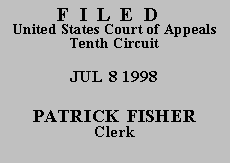

| JERRY D. PRUETT,
Plaintiff-Appellant, v. KENNETH S. APFEL, Commissioner, Social Security Administration, Defendant-Appellee. |
|
Claimant Jerry D. Pruett appeals from the district court's order affirming the decision of the Commissioner of Social Security finding him ineligible for disability insurance benefits. After "closely examin[ing] the record as a whole to determine whether the [Commissioner's] decision is supported by substantial evidence and adheres to applicable legal standards," Evans v. Chater, 55 F.3d 530, 531 (10th Cir. 1995), we affirm.
The Administrative Law Judge (ALJ) found that Mr. Pruett's subjective complaints of disabling pain, fatigue, weakness, and nausea from neck, shoulder, chest, back, testicular, and abdominal problems were not fully credible. As a consequence, the ALJ determined at step four of the five-step sequential evaluation process, see Williams v. Bowen, 844 F.2d 748,750-52 (10th Cir. 1988), that Mr. Pruett was not disabled as of the date his insured status expired (September 30, 1987). (1) On appeal, Mr. Pruett argues that the ALJ: (1) applied improper legal standards to evaluate the credibility of his testimony on his pain and functional limitations and (2) failed to give sufficient consideration to the disability rating of the Veteran's Administration (VA) .
In considering the challenge to the ALJ's assessment of Mr. Pruett's subjective complaints, we must bear in mind that "[c]redibility determinations are peculiarly the province of the finder of fact, and we will not upset such
determinations when supported by substantial evidence." Diaz v. Secretary of Health & Human Servs., 898 F.2d 774, 777 (10th Cir.1990). The ALJ appropriately discussed the medical evidence that led him to believe that Mr. Pruett's problems were not as severe as he alleged. See Kepler v. Chater, 68 F.3d 387, 391 (10th Cir.1995). The record provides substantial evidence for the determination that claimant's subjective claims were not fully supported by the evidence.
Mr. Pruett also asserts that the ALJ erred by ignoring the VA determination that, at the relevant time, he had a sixty per cent disability rating. See Baca v. Department of Health & Human Servs., 5 F.3d 476, 480 (10th Cir. 1993) (findings by other agencies are entitled to weight and must be considered, but are not binding on the Commissioner). We believe this is an inaccurate characterization of the record. The ALJ inquired about the VA's disability determination at the hearing. In his decision, he analyzed the treatment records of VA physicians and stated that the conclusion of nondisability was made after a consideration of the entire record.
The fact that the ALJ drew a different conclusion concerning Mr. Pruett's condition does not constitute legal error. See id.; 20 C.F.R. § 404.1504 (another agency's determination is based on different rules, and is not binding on the the Society Security Administration). Although it would have been preferable for the ALJ to be more explicit in his discussion of the VA disability rating, the lack of detail is not reversible error under the circumstances presented by this case. See Clifton v. Chater, 79 F.3d 1007, 1009-10 (10th Cir. 1996) ("The record must demonstrate that the ALJ considered all of the evidence, but an ALJ is not required to discuss every piece of evidence."); Hamilton v. Secretary of Health & Human Servs., 961 F.2d 1495, 1498-99 (10th Cir. 1992) ("The ALJ stated that he considered all of the evidence; his reliance on medical findings does not allow us to assume otherwise.").
For the reasons stated above, the judgment of the district court is AFFIRMED.
Entered for the Court
Circuit Judge
*. This order and judgment is not binding precedent, except under the doctrines of law of the case, res judicata, and collateral estoppel. The court generally disfavors the citation of orders and judgments; nevertheless, an order and judgment may be cited under the terms and conditions of 10th Cir. R. 36.3.
1. Mr. Pruett was found disabled for purposes of a 1991 Supplemental Security Income application because of back and neck problems arising from a slip-and-fall accident in 1990 and limitations connected with a mental impairment.